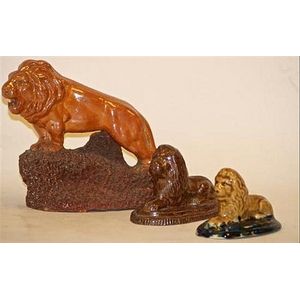Sewer Tile Spaniel Folk Art
You must be a subscriber, and be logged in to view price and dealer details.
Subscribe Now to view actual auction price for this item
When you subscribe, you have the option of setting the currency in which to display prices to $Au, $US, $NZ or Stg.
- Incised - A record of a name, date or inscription, or a decoration scratched into a surface, usually of a glass or ceramic item with a blunt instrument to make a coarse indentation. Compare with engraving where the surface is cut with a sharp instrument such as a metal needle or rotating tool to achieve a fine indentation.
- Salt Glazed - Salt glazing involves throwing salt into the kiln when it is at its highest temperature, usually around 2,300 to 2,400 degrees Fahrenheit (1,260 to 1,320 degrees Celsius). The salt vaporizes and forms a glaze on the surface of the pottery, creating a range of effects depending on how the salt is applied and the firing conditions. This glazing method was first developed in Germany in the 15th century and quickly became popular throughout Europe and North America. It was particularly popular for making stoneware pottery, such as jugs, crocks, and other utilitarian objects.
Salt glazes can produce a range of colors, including gray, brown, blue, and even pink or purple in some cases. The texture of the glaze is typically rough and pebbled, with a matte or satin finish. The process of salt glazing can be unpredictable, with variations in temperature and salt application leading to subtle variations in the finished product.
Salt glazing is still used by potters and ceramic artists although it is less common than it was in the past.
This item has been included into following indexes:
Visually similar items

A large and impressive colonial kauri gum bust, in the form of a Maori mother and child on a wooden base. Cracking commensurate with age. Approx. 30kgs. 50 cm x 60 cm

Gilded wooden figure of the Lohan Rahula, seated in pensive mode, (minor losses), height 25.5 cm

Two Australian glazed earthenware seated lions, possibly Fowler pottery; and a standing lion, front small lion with restorations 20 cm high (3)

A Chinese soapstone carving of a lohan, 11 cm high. Provenance: NSW Private Collection, purchased in Stanley & Co. on 22 Feb 2004
